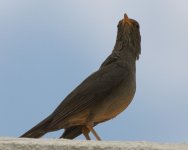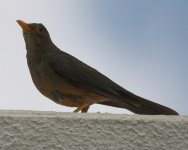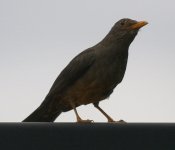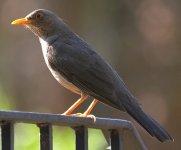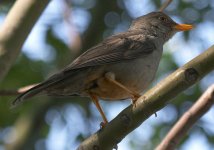-
Welcome to BirdForum, the internet's largest birding community with thousands of members from all over the world. The forums are dedicated to wild birds, birding, binoculars and equipment and all that goes with it.
Please register for an account to take part in the discussions in the forum, post your pictures in the gallery and more.
You are using an out of date browser. It may not display this or other websites correctly.
You should upgrade or use an alternative browser.
You should upgrade or use an alternative browser.
Thrush? (1 Viewer)
- Thread starter leon
- Start date
More options
Who Replied?Is this the same bird?leon said:I suspect this is some kind of thrush, not sure.
Shot on my roof in Pretoria,South Africa.
Attachments

I think it's probably a Kurrichane Thrush Turdus libonyana, although the pictures are quite dark. I think all are of the same species though. It has the pale eye ring of Kurrichane.
Fifebirder said:I think it's probably a Kurrichane Thrush Turdus libonyana, although the pictures are quite dark. I think all are of the same species though. It has the pale eye ring of Kurrichane.
I agree with the eye, what I don't see is the brownish patch that should be infront of the wing shoulder ? This bird is quite commen in my garden, but hardly ever poses for a picture.

I must admit it doesn't look perfect for one, although I'm not sure what else it could be, other than by going down the old hybrid/ escape route - and even then I can't think of anything. The orange flank patch isn't apparent and the dark malar stripe and white submoustachial aren't obvious either. Anyone else got any ideas?
Fifebirder said:I must admit it doesn't look perfect for one, although I'm not sure what else it could be, other than by going down the old hybrid/ escape route - and even then I can't think of anything. The orange flank patch isn't apparent and the dark malar stripe and white submoustachial aren't obvious either. Anyone else got any ideas?
I know this is a male - as he was courting a female. (stretching his wings down next to his body, as to drag them - like pigeons do)
I notice he has a orange/brown coloring between his legs.
Attachments
Charles Harper
Régisseur
I've thumbed the book pretty well (not having graced the continent myself) and have to agree with Kurrichane (the shoulder patch is pretty subtle in my picture). Nothing else has the eye ring and orangey vent.
Posting #2 is pale under. Is it the light?
Posting #2 is pale under. Is it the light?
Yes, posting # 1 and #2 are in the light. Posting two is just after sunrise.Charles Harper said:I've thumbed the book pretty well (not having graced the continent myself) and have to agree with Kurrichane (the shoulder patch is pretty subtle in my picture). Nothing else has the eye ring and orangey vent.
Posting #2 is pale under. Is it the light?
cuckooroller
Registered User
I guess somebody always has to be a party-pooper! For me, all of these photos, different birds, same species, are of Turdus olivaceus smithi.
david kelly
Drive-by Birder

I'd go for Karoo Thrush Turdus smithi, so I agree with Cuckooroller. This seems to have been split from the Olive Thrush and thus giving me an "armchair tick", having seen smithi in Namibia and olivaceus in the Western Cape.
cuckooroller
Registered User
david kelly said:I'd go for Karoo Thrush Turdus smithi, so I agree with Cuckooroller. This seems to have been split from the Olive Thrush and thus giving me an "armchair tick", having seen smithi in Namibia and olivaceus in the Western Cape.
David,
Who split this one? The work by E.K. Urban 1997 in Birds of Africa, Vol. 5, does not seem to have had much echo. I have this still as a subspecies of T. olivaceus on the SM 2003, the Clement's 5° Ed. updated 2003 and on the Howard & Moore 3° Ed. 2003. :h?:
david kelly
Drive-by Birder

The South Africans have split it. The Olive Thrush has been split into Olive Thrush (south and east South Africa and the Eastern Highlands of Zimbabwe, western Mozambique), Mountain Thrush of East Africa; Usambara Thrush; Taita Thrush; and Karoo Thrush.
This means I have two armchair ticks.
This means I have two armchair ticks.
cuckooroller
Registered User
david kelly said:The South Africans have split it. The Olive Thrush has been split into Olive Thrush (south and east South Africa and the Eastern Highlands of Zimbabwe, western Mozambique), Mountain Thrush of East Africa; Usambara Thrush; Taita Thrush; and Karoo Thrush.
This means I have two armchair ticks.
David,
I guess I'm more of a conservationist than a ticker. I have the Robert's List showing the split of smithi. However, I still have roehli, abyssinicus and helleri associated with olivaceus (as well as smithi) on all three more authoritative world lists. I know that some of these lists are reviewing the possibility of elevating helleri to specific status but have no notion on their reviewing the other mentioned subspecies. I don't usually consider something as being really split until there is more consensus on it on the three world lists while considering the work of Peter Ryan and The Fitzpat remarkable, I find that there is a tendency, perhaps for reasons other than taxonomical probity to be split-happy.
Last edited:
david kelly
Drive-by Birder

There certainly does seem to be a lot of taxonomic revision going on from South Africa.. However, if helleri is a good species so is smithi and abyssinicus/roehli as they have no overlap with olivaceus/swynnertoni.
I would say that Olive Thrush is historically lan "overlumped" species. The various subspecies in East Africa are separated from the southern African subspecies by Kurrichane Thrush and with African, Bare-eyed and Somali Thrushes form a group of very similar species, of which smithi is certainly distinctive in appearance and habitat. i remember seeing it in Ais-ais in southern Namibia and thinking "you don't get Blackbirds[ie Turdus merula] here!". It looked far more distinct from olivaceus than any libonya I'd seen in Zimbabwe. Admittedly the abysinnicus I saw in Kenya were more similar to olivaceus but I am happy that these taxa are good species. I'm not so sure about all these larks though!
I would say that Olive Thrush is historically lan "overlumped" species. The various subspecies in East Africa are separated from the southern African subspecies by Kurrichane Thrush and with African, Bare-eyed and Somali Thrushes form a group of very similar species, of which smithi is certainly distinctive in appearance and habitat. i remember seeing it in Ais-ais in southern Namibia and thinking "you don't get Blackbirds[ie Turdus merula] here!". It looked far more distinct from olivaceus than any libonya I'd seen in Zimbabwe. Admittedly the abysinnicus I saw in Kenya were more similar to olivaceus but I am happy that these taxa are good species. I'm not so sure about all these larks though!
cuckooroller
Registered User
Helleri also much resemble merula. I have no problem with splitting species. My only problem, is that I would rather wait until someone thinks to go in and do some reputable mtDNA hybridization and melts on this presumptive "superspecies" so that some valid conclusions might be drawn confronting the degrees of genetic variance along with other factors and presenting this information in a valid forum in a recognized scientific journal. There is still much work to be done and much is being done to finally unravel the ball-of-string presented to us from the work of previous generations both in group associations and, within "over-lumped" species, of their degree of genetic resemblance so that we can finally have a good idea of how they should be considered one in relation to the other. Even given this, it is alway a judgment call in the end as to what degree of genetic variance is required from case to case in order to propose the splitting of a presumptive species. Sooner or later we will get there, but it will take time.
david kelly
Drive-by Birder

The Karoo Thrush (Turdus smithi Bonaparte 1850), a Southern African endemic
Rauri CK Bowie1*, Paulette Bloomer2, Phillip A Clancey3† and Timothy M Crowe1
1 Percy FitzPatrick Institute, University of Cape Town, Rondebosch 7701, South Africa
2 Department of Genetics, University of Pretoria, Pretoria 0002, South Africa
3 Durban Natural Science Museum, PO Box 4085, Durban 4000, South Africa
* Corresponding author, Email: [email protected]
The Olive Thrush (Turdus olivaceus) species complex is characterised by striking geographical phenotypic variation. Recent consensus has been to recognise three assemblages (1) the olivaceus group restricted to southern Africa, (2) the swynnertoni group of the Zimbabwean and southern Malawi highlands and (3) the abyssinicus group of the montane highlands of eastern and central Africa. We re-examined the status of taxa in the olivaceus group of southern Africa, with specific reference to the central-western taxon T. o. smithi using both morphological and molecular evidence. Sequence divergence between T. o. smithi and other members of the olivaceus group averages 3.5% for the cytochrome-b gene and 4–4.5% for the NADH subunit 3 gene of the mitochondrial DNA. There is also both morphological (biometric and plumage) and molecular support for the recognition of T. smithi as a separate species, the common name of which we suggest should be Karoo Thrush.
Rauri CK Bowie1*, Paulette Bloomer2, Phillip A Clancey3† and Timothy M Crowe1
1 Percy FitzPatrick Institute, University of Cape Town, Rondebosch 7701, South Africa
2 Department of Genetics, University of Pretoria, Pretoria 0002, South Africa
3 Durban Natural Science Museum, PO Box 4085, Durban 4000, South Africa
* Corresponding author, Email: [email protected]
The Olive Thrush (Turdus olivaceus) species complex is characterised by striking geographical phenotypic variation. Recent consensus has been to recognise three assemblages (1) the olivaceus group restricted to southern Africa, (2) the swynnertoni group of the Zimbabwean and southern Malawi highlands and (3) the abyssinicus group of the montane highlands of eastern and central Africa. We re-examined the status of taxa in the olivaceus group of southern Africa, with specific reference to the central-western taxon T. o. smithi using both morphological and molecular evidence. Sequence divergence between T. o. smithi and other members of the olivaceus group averages 3.5% for the cytochrome-b gene and 4–4.5% for the NADH subunit 3 gene of the mitochondrial DNA. There is also both morphological (biometric and plumage) and molecular support for the recognition of T. smithi as a separate species, the common name of which we suggest should be Karoo Thrush.
cuckooroller
Registered User
Thanks David,
I will make a mental note and watch for further developments. The variance for smithi certainly depones for a recognized split. It would seem that they are considering three superspecies and we'll have to wait and see how these are ultimately eviscerated. Appreciate the time spent in informing me.
I will make a mental note and watch for further developments. The variance for smithi certainly depones for a recognized split. It would seem that they are considering three superspecies and we'll have to wait and see how these are ultimately eviscerated. Appreciate the time spent in informing me.
cuckooroller said:Thanks David,
I will make a mental note and watch for further developments. The variance for smithi certainly depones for a recognized split. It would seem that they are considering three superspecies and we'll have to wait and see how these are ultimately eviscerated. Appreciate the time spent in informing me.
I am slightly confused now. I have seen olive thrush here before, more out of town, and the orange colors are quite distinct. These thrush's in my pictures are commen in my garden (and to e honest that's why I have not spent time to photograph or ID them, just always reffered to them as thrush) If they are Karoo thrush the eyes (and colours confuse me). thank you for the help so far. I am out shooting birds today, will only be back tom. Will check my photo-recods if I have better examples. I would really like to be able to identify these birds, and know what to look for. My sasol guide lists the Karoo thrush, Olive Thrush and Kurrichane Thrush amoung others.
Again, thank you for the help.
Rasmus Boegh
BF member
Leon,
As correctly mentioned by Steve and David your birds are cleary Karoo Thrurshes (T. smithi). They are rather easy to recognize by combination of relatively dark underparts, rufous on belly being relatively restricted, white vent (can be very hard to see) and small eye-ring. This last feature is not always present, but such cases may be nothing but hybrids with T. olivaceus.
Regarding swynnertoni: This is still retained as a sub-species of T. olivaceus, basically because more tissue/blood samples are needed of this relatively poorly known taxa. T. abyssinicus has been proposed officially, and will probably be recognized in the varius next check-lists. Regarding roehli, helleri etc... I wouldn't even dare commenting (even if it could give me some of those infamous armchair ticks)...! Having said that, T. helleri may be the most distinct thrush I have ever seen in Africa, more so than T. smithi. Anyways, much works is still needed in the African Turdus; just look at T. pelios!
As correctly mentioned by Steve and David your birds are cleary Karoo Thrurshes (T. smithi). They are rather easy to recognize by combination of relatively dark underparts, rufous on belly being relatively restricted, white vent (can be very hard to see) and small eye-ring. This last feature is not always present, but such cases may be nothing but hybrids with T. olivaceus.
Regarding swynnertoni: This is still retained as a sub-species of T. olivaceus, basically because more tissue/blood samples are needed of this relatively poorly known taxa. T. abyssinicus has been proposed officially, and will probably be recognized in the varius next check-lists. Regarding roehli, helleri etc... I wouldn't even dare commenting (even if it could give me some of those infamous armchair ticks)...! Having said that, T. helleri may be the most distinct thrush I have ever seen in Africa, more so than T. smithi. Anyways, much works is still needed in the African Turdus; just look at T. pelios!
Last edited:
Users who are viewing this thread
Total: 2 (members: 0, guests: 2)




